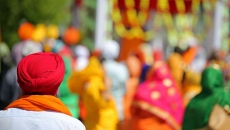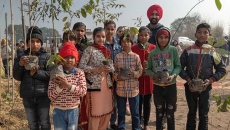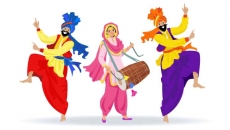The Sikh history is enshrined with glorious sagas, plenty of struggle, relentless battles and the perseverance of some remarkable warriors and saints who have played a key role in shaping the social, religious, and political milieu of the Sikh faith. This Vaisakhi, we bring to you some of the most significant and revered Sikh figures, who have made their mark in the pages of Sikh history eons ago.
Maharaja Ranjit Singh (13 November 1780 – 27 June 1839)
Popularly known as Sher-e-Punjab or Lion of Punjab, history pages are replete with tales of Maharaja Ranjit Singh’s bravery and conquests. A man of valour, Ranjit Singh was the first Maharaj of the Sikh Empire and reigned it from 1801 to 1839.
Born on November 13, 1780, to Maha Singh and Raj Kaur in Gujranwala, Punjab region (now in Pakistan), Ranjit Singh displayed all the traits of becoming a great leader from an early age. He lost sight in his left eye during infancy due to smallpox, however, loss of eyesight and lack of education didn’t stop Ranjit Singh from becoming one of the greatest warriors.
When kids his age were busy playing, Ranjit Singh showed unimaginable gallantry and fought his first battle alongside his father at the age of 10. In 1792, 12-year-old Ranjit Singh lost his father, and the responsibility of leading his father's Sukerchakia Misl (confederacy) estates as chief came upon his young shoulders. Needless to say, the young leader once again showed his indomitable spirit and commendably took charge of his inheritance and even survived an attack made on his life by Hashmat Khan when he was merely 13 years old.
When Ranjit Singh was 15-year-old, he was married to the daughter of a chieftain of the Kanhayas — Mehtab Kaur, and for many years his affairs were directed by his mother-in-law, Rani Sada Kaur, who guided his destiny and helped him to acquire the Sikh Empire.
Ranjit Singh fearlessly fought several wars to expel the Afghans, amongst which was the epic conquest of the Lahore Fort, where he rode up to Samman Burj and challenged Shah Zaman to single combat. Shah Zaman was defeated and Ranjit Singh was rightfully proclaimed as the ‘Maharaja of Punjab’ at age 21 on 12 April 1801, on the day of Baisakhi. Under Ranjit Singh’s outstanding leadership, his empire continued to flourish in the Punjab region.
Before Ranjit Singh’s rise, the Punjab region had several warring misls (confederacies), seeing the need for unification of the Sikh community the Maharaja commendably absorbed and united all the Sikh misls and also took over the other local kingdoms to form the Sikh empire.
His domains extended from the Khyber Pass in the northwest to the Sutlej River in the east and from the Kashmir region at the northern limit of the Indian subcontinent southward to the Thar (Great Indian) Desert. Interestingly, the Maharaja was never conquered by the Afghans and his Punjab region happens to be the only region that successfully defeated Afghanistan. What’s more, such was the valour of the Maharaja that when Afghan prince Shuja Shah Durrani needed help to win his throne back, he approached Ranjit Singh for assistance and gave him the coveted Koh-i-Noor diamond in return for his help.
Apart from bringing together all the Sikh territories and building the prosperous Sikh Empire, Ranjit Singh also introduced reforms, modernisation, investment into infrastructure and general prosperity. Ranjit Singh was also a secular and forward-thinking leader and his Khalsa army included Sikhs, Hindus, Muslims and European warriors and generals.
Maharaja Ranjit Singh is not only credited for immensely contributing to the rich Sikh cultural and artistic renaissance, but he is also responsible for the rebuilding of the Harimandir Sahib in Amritsar, which is now known popularly as the Golden Temple. He also built the Takht Sri Patna Sahib, Bihar and Hazur Sahib Nanded, Maharashtra. The great Maharaja has indeed made a distinctive mark in the annals of history.
Rani Sada Kaur (1762-1832)

Talk about Maharaja Ranjit Singh, and you can’t miss mentioning the formidable force behind his success — his mother-in-law — Rani Sada Kaur. The feisty Rani was indisputably one of the most remarkable characters in Sikh history, who played a key role in the spread of Maharaja Ranjit Singh’s domain and the expansion of the Sikh Empire.
Born in 1762 to Sardar Daswandha Singh Dhaliwal, Rani Sada Kaur was married to Gurbakhsh Singh, the son of the chief of the Kanahiya Misl at a young age. After Gurbaksh Singh was killed by Ranjit Singh’s father Maha Singh, Sada Kaur, an ambitious and intelligent young woman, served as the chief of the Kanhaiya Misl from 1789 to 1821. Blessed with exceptional foresight, it was Rani Sada Kaur who proposed the marriage of her only daughter — Mehtab Kaur, to Ranjit Singh’s mother Raj Kaur, when Ranjit Singh was just six-year-old. In 1792, when Ranjit Singh’s father Mahan Singh passed away, making the 10-year-old Ranjit his heir, Sada Kaur took it upon herself to run the affairs of his state with the help of Mahan Singh’s Diwan – Lakhpat Rai. Sada Kaur became his regent and used both Kanheya and Sukerchakia misals to push Ranjit forward.
While Ranjit Singh was courageous and displayed great leadership qualities, it was Rani Sada Kaur who was the guiding force behind him. In fact, very few people know that Rani Sada Kaur was also instrumental in making Ranjit Singh the king of Lahore.
It so happened that the people of Lahore were tired of the rule of the Bhangi misl and requested Sada Kaur and Ranjit Singh to take over Lahore. Sada Kaur had great wisdom and far-sightedness, she convinced Ranjit that whoever controls Lahore controls Punjab. Thus, Ranjit Singh along with Sada Kaur attacked Lahore with 25,000 troops and conquered Lahore. Thereafter, the son-in-law and mother-in-law duo fought several battles together and she also played a huge role in unifying the several Sikh Misl, however, their relationship turned sour when Ranjit Singh married Datar Kaur and declared their first-born Kharak Singh as his heir. The relationship kept growing bitter and ended on an unhappy note. Sada Kaur died in Lahore in 1832.
Maharani Jindan Kaur (1817 – 1 August 1863)

Maharani Jindan Kaur is not just well-known in the history of Sikhism but is undoubtedly one of the most remarkable personalities of 19th century Indian history. While her primary identity was that of the youngest wife of the first Maharaja of the Sikh Empire — Ranjit Singh, the gutsy Rani carved a name for herself in the annals of history by fearlessly waging two wars against the British rule in India.
Popularly known as Rani Jindan she proved to be a mighty regent to her son Duleep Singh who came into power at the age of 5 after the assassinations of Ranjit Singh's first three successors. Though she may have made big strategic mistakes due to her lack of military expertise and young age (she was in her early 20s), Rani Jindan was a fierce ruler, who was feared by the British. The British regarded her as a threat to their power in India and described her as the ‘Messalina of Punjab.’
Born to Manna Singh and Mataji Kaur, in a small village called Chicharwali, of Sialkot district, Gujranwala (now Pakistan), Jindan Kaur was renowned for her beauty. It is said that having heard tales about her beauty and virtues, Maharaja Ranjit Singh, sent his arrow and sword to her village and sought her hand from her father. Jindan Kaur was married to the Maharaja at the age of 18 in the year 1835.
Apart from her valour and beauty what also makes Rani Jindan Kaur extraordinary is how she defied age-old traditions like Sati and purdah, which were dominant in those days, spearheaded court meetings and took a keen interest in running the kingdom on behalf of her son.
Despite being confronted with several obstacles, which tested her political and administrative skills, Rani Jindan proved her mettle as a regent, introduced changes in the revenue system, reconstituted the Supreme Council of the Khalsa and restored a balance between the army and the civil administration. She held regular courts, did public hearings, ran state business, and reviewed troops.
After the British’s victory in the Anglo-Sikh War in 1846, the British seized Punjab, imprisoned and exiled Rani Jindan Kaur, and separated her from her son Duleep Singh, as they still considered her influential enough to revive the Sikh dynasty. However, the British couldn’t keep the daring young queen behind the bars for too long. Rani Jindan managed to escape the prison by disguising herself in beggars’ rags. She even scrawled a taunting note for her British captors, which read — “You put me in a cage and locked me up. For all your locks and your sentries, I got out by magic… I had told you not to push me too hard – but don’t think I ran away. Understand well, that I escape by myself unaided… don’t imagine I got out like a thief.”
After her escape, Jindan then traversed 800 miles to reach a sanctuary in Nepal and eventually reached England where she was reunited with Duleep. Unfortunately, the daring queen never regained the Sikh kingdom.
Hari Singh Nalwa (1791- 30 April 1837)

Known as Baghmar (Tiger-killer) because of his bold act of killing a tiger that attacked him with his bare hands, Sardar Hari Singh Nalwa was the Commander-in-chief of the Sikh Empire and was regarded as one of the most feared Sikh warriors, who once tamed the notorious Afghan forces.
One of the most trustworthy sardars in Maharaja Ranjit Singh’s army, Hari Singh Nalwa is known for his role in the conquests of Kasur, Sialkot, Attock, Multan, Kashmir, Peshawar and Jamrud. Hari Singh Nalwa was also responsible for expanding the frontier of the Sikh Empire beyond the Indus River right up to the mouth of the Khyber Pass.
Born in Gujranwala in the year 1791, Hari Singh was always inclined towards martial arts and displayed shrewd intellect and physical prowess from a young age. He started training in horse riding and martial arts at the age of 10, and when he was 13, his mother sent him to Maharaja Ranjit Singh to resolve a property dispute. This meeting led to the Maharaja giving him a position at the court as a personal attendant. Soon enough, Hari Singh impressed the Maharaja with his gallantry and became Ranjit Singh’s right hand and received the commission of 800 horses and footmen along with earning the title of Sardar.
Over the course of 30 years, from 1804 to 1837, as the commander-in-chief, Nalwa fought several battles against Afghans and shot to fame as one of the most feared Sikh warriors who sent shivers down the spines of Afghan forces.
Despite having all the odds against him in each battle, Hari Singh defeated the Afghans in all the battles with his incredible skills and warfare tactics. He gained control over various regions along the boundary of Afghanistan and also prevented Afghans from entering Punjab through the Khyber Pass, which was the main route that foreign invaders used to enter India from 1000 AD till the early 19th century.
After a series of victories, the epic battle of Jamrud proved to be Nalwa’s last battle. In that battle, Dost Muhammad Khan along with his five sons fought against the Sikh army, which only had around 600 men and limited supplies. At that time, Nalwa was in Peshawar and marched towards Jamrud to save the Sikh army which was surrounded by Dost Mohammad’s troops. When the Afghan troops heard about his arrival, they started leaving the battleground in haste. However, Nalwa got seriously injured and later succumbed to his injuries. Interestingly, the brave warrior, before his death, told his army to not disclose the news of his demise till the forces from Lahore arrived to support them.
Historians strongly believe that, had it not been for Maharaja Ranjit Singh and his commander Nalwa, Afghan forces would have taken control of Peshawar and the northwest frontier, which is part of Pakistan now, thus making these areas a part of Afghanistan. Resulting in Afghanistan not only making these areas a part of their country but it could have also led to more Afghan incursions into Punjab and Delhi.
Here's a grand salute to one of the fiercest warriors in Sikh history.
Mai Bhago

An extraordinarily skilled warrior-saint, Mai Bhago became immortalized in the pages of history after she motivated 40 Sikh warriors to return to the battlefield and courageously led the small group against thousands of Mughals in the epic battle of Muktsar in 1705.
Born in the Chabal Kalan district of Punjab, into a devoted Sikh family, Mai Bhago, also known as Mata Bhag Kaur, was trained in Shaster vidya at a young age and displayed remarkable proficiency in the use of arms. Since her childhood, she was highly influenced by the teachings of Guru Gobind Singh and was his ardent devotee.
Cautioned by the rising power of the Sikhs, in the early 1700s, the Mughals, under the orders of Aurangzeb, launched an attack on Anandpur, where Guru Gobind Singh resided and forced evacuation by stopping food supplies. Grappled by the fear of the Mughals, during the Anandpur siege, some Sikh men deserted the Guru and renounced their association with him. Mai Bhago, a staunch Sikh, was distressed by the incident and openly criticized the men for abandoning their Guru in an adverse situation.
Eventually, Mai Bhago not only succeeded in persuading them to meet the Guru and apologize but also led them into the battlefield to fight the Mughal army to save Guru Gobind Singh. Taken aback by her courage, the Mughals were forced to retreat. However, all the 40 warriors died in the battle and attained martyrdom. Guru Gobind Singh blessed the 40 men as Chali Mukte (the liberated ones). Mai Bhago survived the battle and stayed on with Guru Gobind Singh Ji as one of his bodyguards, arming herself with a large lance (weighing about 102 pounds) and musket. After the death of Guru Gobind Singh in 1708, Mai Bhago dipped herself deep into meditation and followed the path of Guru (Gurmat). The very place where she meditated and taught for the rest of her life is now a centre of worship and learning called Gurudwara Tapashthan Mai Bhaigo.
Sardar Sham Singh Attari (1790- 10 February 1846)

Talk about great Sikh warriors, and Sardar Sham Singh Attari’s name is sure to be topping the list. Also known as the grand old lion of Attari, tales of Sardar Sham Singh Attari’s heroism and bravery are inspiring even today. Born in the 1790s to well-known Jat farmers in the town of Attari (a few kilometres from the border of India and Pakistan), Amritsar, in the Majha region of Punjab, India, Sham Singh was the general of the Sikh Empire led by Maharaja Ranjit Singh.
As a child, Sham Singh Attari was educated in Gurmukhi and Persian, and also displayed outstanding martial arts skills. Noticing his extraordinary fighting abilities and valour, Maharaja Ranjit Singh made him the Jathedar of 5000 horsemen in his army. Thereafter, Sham Singh, who was also known as Attariwala actively led military expeditions into the northern frontier. His unconquerable character along with his excellent martial arts skills made him shine through various expeditions, notably in the campaign of Multan, the campaign of Kashmir, the campaign of the Frontier Province etc. But what really etched his name in history is his jaw-dropping courageous role in his last battle – The Battle of Sobraon, which was fought on 10 February 1846, between the forces of the East India Company and the army of the Sikh Empire of Punjab.
Historians believe that the battle of Sabraon of the First Sikh War (1846) where Sham Singh Attari was in command of troops would never have been lost, had it not been for traitors like Tej Singh and Lal Singh, the commanders of the Sikh Army, who starved the troops of ammunition and other administrative support.
It is also recorded that the night before the battle, Tej Singh had come to Sham Singh's camp and tried persuading him to beat a retreat while the pontoon bridge was still intact. A loyal soldier, Sham Singh was furious at the proposal and Tej Singh had said to have taunted him saying if he was so brave, he should pledge to fight until his last breath. Sham Singh immediately asked for the Holy Granth to be brought and standing before it in all humility took a vow that he would either return victoriously or perish in the battle.
Unfortunately, Tej Singh and Lal Singh had already given the British their positions of guns, etc. and Tej Singh fled across the Sutlej and sank a part of the bridge of boats after him, trapping nearly 20,000 of the Sikh Khalsa Army on the east bank. But none of this deterred Sham Singh Attari from fearlessly charging against his enemies. Attariwala, the white beard hero, donning saffron robes, rode a top of his horse and dauntlessly went into the battlefield drawing the sword in his right hand and shouting Sat-siri-akal. As he rode, the British army was taken aback as they had never seen any heroic act like this before. However, cause of Tej Singh’s betrayal, Sham Singh couldn’t hold the fort for too long and the old Sardar fell at last. When Sham Singh’s body was found, seven bullets had pierced his chest. The battle of Sabraon was lost but out of respect for the brave warrior, the British ordered a ceasefire and allowed Sham Singh's troops to take his body away. The body was brought back to Attari with full respect on an elephant back after seven days of march. His wife performed sati at his funeral pyre. (This is the last Sati recorded in history.) As a respect, to the brave warrior, even today people from Attari do not wear saffron colour at weddings or on any other joyous occasions.
Mata Khivi (1506 - 1582)

Mata Khivi also known as Khivi or Bibi Khivi is renowned amid the Sikh community as the person who established the tradition of Langar, the free kitchen, which is still considered the highest form of selfless offering.
Born in 1506 to Devi Chand and Karan Devi, a wealthy Marwaha Khatri family of village Sangarkot near Khadoor Sahib, Mata Khivi was the wife of the second Sikh guru — Guru Angad.
Mata Khivi’s father Devichand was a money lender and a businessman. As for the old traditions, Mata Khivi was also married early in her childhood at the age of 13 in 1519. Her husband Lehna also belonged to the same village and later on, he became the second guru of Sikhs, Guru Angad. Once Guru Angad Dev was given the Guruship, Mata Khivi got actively involved in spreading Sikhism’s teachings to women.
It was during this period that decided to take up Guru Nanak’s tradition of giving free meals to everyone forward and established the Langar system, which even today serves meals to all free of charge, regardless of religion, caste, gender, economic status, or ethnicity across the globe.
Mata Khivi managed the Langar system in a systematic manner, which was also known as Mata Khivi ji da Langar. She institutionalised the tradition of langar and set rules and training methods for volunteers. She not only made it work in a way that will never create any discontinuation of the tradition but also established a method where visitors could participate and play their part in the offering, which is called Sewa Tradition in Sikh temples.
Jassa Singh Ahluwalia (3 May 1718 – 23 October 1783)

Sardar Jassa Singh Ahluwalia is one of the most celebrated figures in Sikh history. An intelligent and powerful administrator, Jassa Singh was a prominent Sikh leader during the period of the Sikh Confederacy, who led the Ahluwalia Misl. A legendary warrior, Jass Singh victoriously fought several battles against the Afghans and Mughals and was also responsible for bringing Mughal’s centre of power at that time (Red Fort) under the Khalsa flag. The Khalsa honoured Jassa Singh with the title of Sultan-ul-Qaum (King of the nation) when he captured Lahore in 1761.
Jass Singh was born in 1718 in a village called Ahlu near Lahore, at a time when the spirit of Punjab was completely crushed and the freedom movement was brought to a standstill after the horrific execution of the legendary Sikh warrior Banda Bahadur and his followers. The Ahlu village he was born in, was established by his ancestor, hence Sadda Singh used the name Ahluwalia (meaning from Ahluwal).
Jassa Singh was only 5 years old when his father passed away and he spent the next 7 years with his mother in Delhi in the company of Mata Sundari, Guru Gobind’s widow where he imbibed the lessons of the Gurus, and became an ardent devotee of Guru Gobind and made his mission his own. It wasn’t until he was 12-year-old that Jassa Singh left Delhi and joined his mentor — Kapur Singh’s Dal Khalsa, where he honed his martial arts skills and became a fearless warrior. The young and daring Jassa Singh soon enough made his mark and in March 1748 was appointed as the commander-in-chief of the Dal Khalsa. In 1753, Kapur Singh, also announced Jassa Singh as the head of the panth, giving him Guru Gobind Singh’s mace to reinforce his leadership of the community. Now there was no stopping the legendary leader.
Under his spectacular leadership, the Dal Khalsa began its conquest of the whole of Punjab. His victories included the defeat (in combination with Kaura Mal) of Shah Nawaz of Multan, he conquered Khwaspur and Fatehabad in 1753, he overpowered Aziz Beg and Bakhinda Khan (1754), the commanders who attacked Amritsar. He then defeated Buland Khan at Mahilpur (1757) and again in 1757 he conquered Saadat Khan, Abdali’s representative at Jalandhar.
In 1761, Jassa Singh along with Ranjit Singh’s grandfather — Charat Singh Suckerchakia, defeated Ubaid Khan and took over Lahore, thus freeing Punjab after 700 years.
Apart from freeing people from the tyrannical oppressors, Jass Singh also instilled in the Sikhs faith in God and the belief that if you are just, ultimately victory has to be yours. No wonder he was regarded as a warrior-saint sent for Punjab’s salvation.
Bebe Nanaki (1464-1518)

Revered as one of the most important figures of Sikhism, Bebe Nanaki holds a special place in Sikh history. Not only was she the elder sister of Guru Nanak dev ji, the founder and first Guru of Sikhism, but she was also his first disciple and is often known as the first Gurkish. It was Bebe Nanaki, who first noticed that her younger brother was no ordinary man and had a philosophical and spiritual inclination.
Born in 1464 to Mata Tripta and Mehta Kalu ji in a village called Chahal, Lahore, now in Pakistan, Bebe Nanaki was five years elder to Guru Nanak Devji. She was born at the house of her maternal grandfather and grandmother, who loved her a lot and named her Nankian, which means house of maternal grandparents. Later the word Nankian was changed into Nanaki. Interestingly, her brother was named after her, and people would call him Nanak of Nanaki. The brother-sister shared a beautiful bond and heart-warming tales of their relationship are narrated in some of the Sakhis. Bebe Nanaki was extremely fond of her younger brother and often protected Nanak from their father’s wrath. There are also many stories of Nanaki’s deep and devoted affection for her brother, Nanak.
Bebe Nanaki was also instrumental in getting Nanak settled and finding a suitable match for him — Mata Sulakhni. When Bebe Nanaki was married in 1475 to Bhai Jai Ram, a revenue officer at Sultanpur, Nanak was sent to live with them. Bhai Jai Ram not only got Nanak employed as a storekeeper under the Nawab of Sultanpur but along with Bebe Nanaki, he also took it upon himself to arrange his wedding.
Nanaki didn’t have any children of her own and she helped Mata Sulakhni in bringing up her sons, Sri Chand and Lakhmi Chand.
When Guru Nanak Devji planned to start his missionary work to spread his message in the world, Bebe Nanaki assured him that she will look after his family in his absence. In fact, she also is the one who encouraged him to use music as an instrument of devotion to God. Nanaki knew of Guru Nanak’s musical talent, and also bought a Rebab (musical instrument with strings) for him. This tradition of recitation of hymns with the help of music is still prevalent in Sikhism and has played a big role in the preachings of Sikhism.
Bebe Nanak lived in Sultanpur for about forty years and breathed her last in presence of her brother while Guru’s sacred hymn, Japji Sahib, was being recited to her. Bebe Nanaki had unconditional love for Nanak, for her, Nanak was not only her brother (Veer) but also her Guru (Peer).
Bhagat Puran Singh ((4 June 1904 – 5 August 1992)

None can define Sewa, the nature of human life in Sikhism, better than Bhagat Puran Singh. Devoted to the service of mankind, Bhagat Puran Singh was an epitome of love, kindness and compassion. He was an Indian writer, environmentalist and philanthropist, who spent all his life tirelessly doing humanitarian work.
Bhagat Puran Singh was born into a Hindu family on 4th July 1904 in Rajewal Ludhiana district of Punjab and was given the name Ramji Das. However, later in life, being impressed by the Guru’s teachings and the philosophy of selfless service of Sikhism, he chose to become a Sikh.
As a young child, Bhagat Puran Singh grew up listening to stories of Ramayana, Mahabharata and Bhagwad Gita from his mother. His mother played a huge role in inculcating the feelings of compassion, sympathy and love in him for all humans and animals.
After his father’s death, his mother shifted to Lahore with him, where he began visiting the Gurudwara Dehra Sahib. Bhagat Puran Singh started helping in the Gurudwara by cleaning, managing cattle, serving people helping in the kitchen etc. He would even clear the streets of Lahore and cremate the unclaimed dead bodies. He took care of the destitute and took the sick to the hospital for treatment. Realizing the joy of selfless service, Puran Singh decided to spend the rest of his life dedicated to humanitarian work.
One day in 1934, a child with leprosy was left at Gurudwara and Bhagat Puran Singh took this four-year-old under his care and named him Piara Singh. This episode completely transformed his life. There on, he made it his life’s mission to serve the destitute and helpless in whatever ways possible.
He established a home for the sick and the disabled in Amritsar called Pingalwara. Even today, The All-India Pingalwara Charitable Society has retained all the essence of Bhagat Puran Singh’s philosophies and teachings and is completely devoted to several humanitarian works.
Bhagat Puran Singh also campaigned for soil erosion and pollution awareness and wrote many books about environmental awareness. In 1981, Bhagat Puran Singh was honoured by the Government of India with the Padma Shri award, for his exceptional and distinguished service to humanity. In 1991, he was nominated for the Nobel Peace Prize for his humanitarian work.






